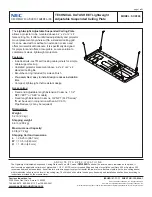
Because OPTIMOD-FM controls peaks, it is irrelevant whether the audio link feeding
OPTIMOD-FM’s input terminals is phase-linear. However, the link should have low noise,
the flattest possible frequency response from 30-15,000Hz, and low non-linear distortion.
We very strongly recommend that you use the 8200’s internal stereo encoder to feed
the output of the encoder directly to the baseband input of the exciter through less than
100 feet (30 meters) of coaxial cable. You will achieve a louder sound on the air, with
better control of peak modulation, than if you use an external stereo encoder.
The shorter the baseband cable run from OPTIMOD-FM to exciter, the less likely that
ground loops or other noise problems will occur in the installation. If you require a long
cable run, you can use Orban’s CIT25 Composite Isolation Transformer to break any ground
loops. This transformer will ordinarily cure even the most stubborn hum or noise caused by
the composite connection between OPTIMOD-FM and the exciter. Its instruction manual
contains complete information on its installation and application.
If a separate stereo encoder must be used, feed the encoder directly from the 8200’s left and
right analog outputs. If possible, bypass the pre-emphasis network and the input low-pass
filters in the encoder so that they cannot introduce spurious peaks. Because of their special
design, OPTIMOD-FM’s pre-emphasis network and low-pass filters perform the same
functions while retaining tight peak control.
Transmission from Studio to Transmitter
There are five types of studio-to-transmitter links (STLs) in common use in FM stereo
service: composite baseband microwave, digital, video STLs with PCM adapters, analog
land line (telephone/post line), and dual microwave.
Except for the composite baseband microwave STL and certain digital links, all these links
carry the left and right channels directly or in some encoded form other than the standard
19kHz pilot-tone stereo baseband. These links are normally fed both left and right audio
channels in non-encoded form, and their output is in the form of left and right channels.
Composite baseband microwave:
The composite baseband microwave STL carries the standard pilot-tone stereo baseband,
and is therefore fed from the output of a stereo encoder located at the studio site. The receiver
output of the composite STL is the stereo baseband signal, which is applied directly to the
wideband input of the FM broadcast transmitter’s exciter. Thus, no stereo encoder is needed
at the transmitter.
In general, a composite microwave STL provides the highest audio quality, as long as there
is a line-of-sight transmission path from studio to transmitter of less than 10 miles (16 km).
If not, RF signal-to-noise ratio, multipath distortion, and diffraction effects can cause serious
quality problems.
Where a composite STL is used, use the 8200’s stereo encoder to drive the composite STL
transmitter from the encoder’s composite output.
OPTIMOD-FM 8200
INTRODUCTION
1-13









































